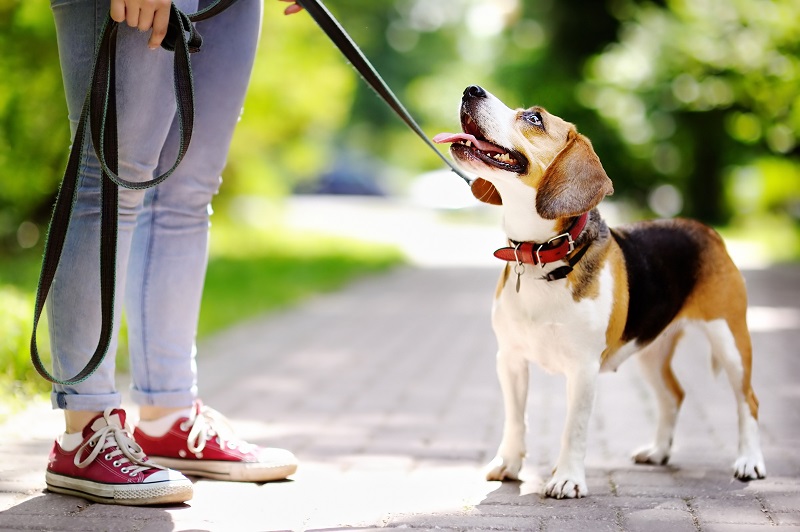If you were asked to describe your dog’s character, you might say that they’re sprightly, excited and up for any adventure. Unfortunately, this isn’t always the case. Our canine companions are now facing epidemic levels of obesity, lethargy and heart disease – not to mention a growing number of behavioural issues.
While their modern diets undeniably play a role in causing these problems, the lack of sufficient exercise is just as much of a factor. That’s not to say there aren’t limits. Too much physical activity can also negatively impact their wellbeing. So, how much exercise does your dog actually need? Let’s find out.
Table of Contents
For Puppies
Growing dogs require a careful balance between rest and movement to stay healthy. You don’t want to exhaust their fragile ligaments or overstimulate them into hyperactivity. Short and sweet exercise sessions are key.
Make the most out of your workouts by incorporating socialisation and bonding activities, which lend to a better relationship with your dog in the long run. Puppies enjoy exploring new environments and familiarising themselves with the home and garden. In doing so, they naturally stay active.
Stick to areas where your pup can focus on you and not become overwhelmed by other distractions. The general guideline here is to add five minutes of physical activity per session for each month of age.
Don’t forget to give their brain the occasional workout by teaching tricks and practicing ‘follow me’ exercises.
For Adult Dogs
There are several factors that come into play here. This includes age, health, breed and physical ability. It’s a good idea to start by reading up on some information about your dog’s specific breed. Athletic dogs can require more daily movement than large breeds, for instance. Keep the following best practises in mind:
Mix it Up: Make things interesting by incorporating different locations and activities. New sights, sounds and smells will stave off boredom and keep both of you motivated to head out.
Take it Slow: When you’re calm and patient, your dog will mirror your behaviour.
Follow the Leader: You don’t necessarily have to do everything off-lead in large open fields. As long as your pup is in the moment with you, chances are that they will enjoy it. This includes when you’re relaxing at home.
Your exercise sessions are also the perfect time to teach your adult dog something new. Trotting poles and balance planks can be used to improve their balance and coordination. Weave poles can be used for lead work and discipline. Hiding toys or treats will stimulate their sense of smell. It’s also a great way to learn teamwork.
Remember that this doesn’t happen around the clock. Dogs need time alone to practise self-calming and independence. Too much stimulation will bring them to demand your attention all the time. Long walks and intense sessions are best followed with a rest day.
For Senior Dogs
As you can probably imagine, exercising with older dogs requires some re-adjustment. Walks should be taken at their pace and there shouldn’t be any pressure to push harder. Seniors often enjoy stopping to investigate a certain place, which can lead to sniffing around and exploring. Who knows, they might just chase a squirrel or two.
Understanding Exercise
Knowing how much exercise your dog needs is all fair and well, but why exactly is it important? Aside from reducing the risk of disease and obesity, physical activity contributes to positive growth in several ways. This includes:
- Strengthening bones and joints
- Improving heart and lung function
- Building and maintaining muscle
Most of this happens after exercise as the activity itself breaks down tissue. The fibres are then repaired during the rest period before becoming stronger and more efficient, which is why taking a break is so important. Too much exercise can also lead to a leaky gut, as prolonged periods of increased stress damage the gut lining.
Another key factor to consider here is nutrition. Your dog won’t be able to reap the benefits of exercise on a pure diet of processed kibble. Commercial foods may even be more harmful than a lack of physical activity. Your best bet is to opt for a natural and complete raw dog food diet.
Start by reading up on this guide about raw dog food for beginners on the Bella and Duke blog. They’re a raw dog food UK subscription service that delivers custom meals to your door. Their raw feeding guide is a helpful primer on what your pup should be eating.
Conclusion
Ending off with a few extra tips, remember to sprinkle in some variety by changing the intensity and duration of your dog’s workout sessions. Consulting a vet about the individual needs of your pup is also a good idea. Don’t forget to pay attention to your exercise buddy and take notice of any changes to their behaviour.
Rest-assured that with a bit of determination, you can get into a healthy and productive exercise routine with your dog in due course.

